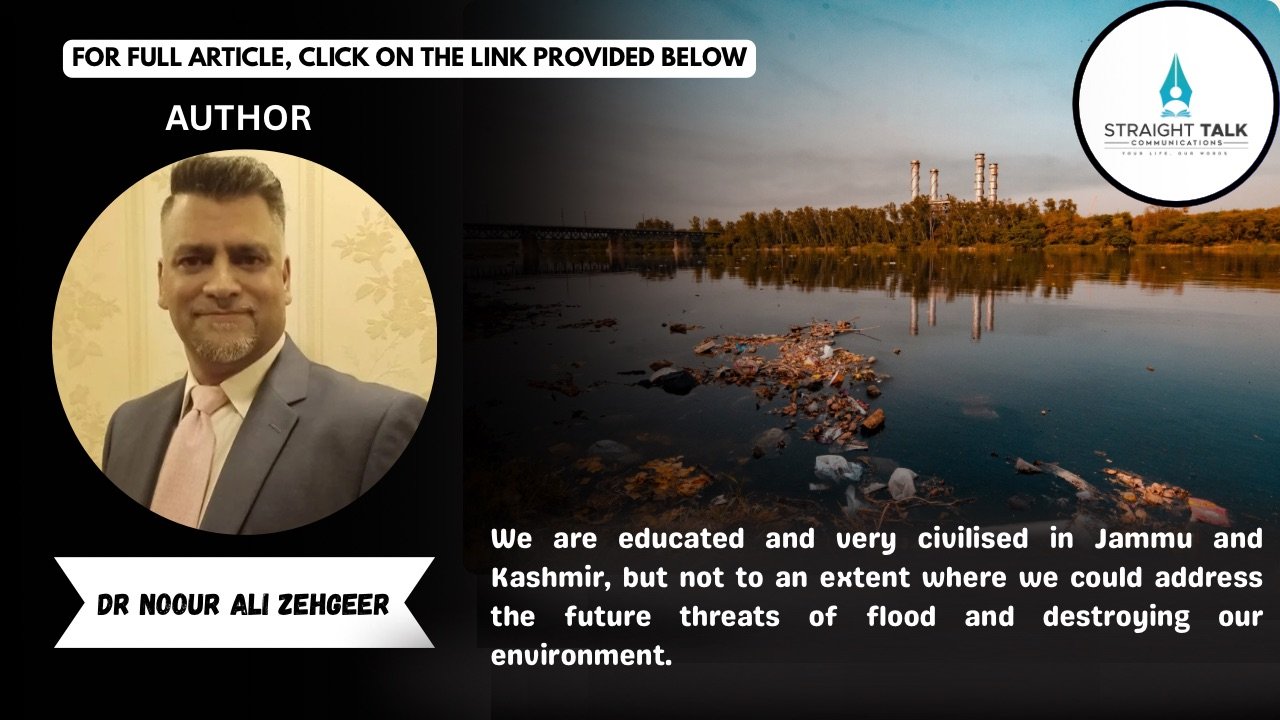Drowning in Our Own Waste: Jhelum’s Silent Plea for Survival

Dr Noour Ali Zehgeer
We are educated and very civilised in Jammu and Kashmir, but not to an extent where we could address the future threats of flood and destroying our environment. We as Kashmiri’s have never shown respect to the nature provided by Allah. Government and people of the region are equally responsible for this destruction and after effects caused by the rains. We have gravely abused every water body and used them for our personal gains. Adding fuel to this catastrophic situation, tourists who come here to enjoy, destroy our environment by throw garbage anywhere and everywhere. The shikara rides are another way of polluting the Lake by throwing bottles and empty packets in it.
Last week, the River Jhelum—often described as the very vein of Kashmir—presented a disturbing picture. Instead of glistening waters carrying life, its surface was littered with garbage: plastic bottles, disposable cups, torn polythene, splintered wood, and heaps of household refuse. What should have been a flowing river, looked more like a moving dump yard, shocking those who stood on its banks.
“It seemed like the river was gasping for air,” said Ghulam Nabi, a bookseller from Maisuma, staring at the polluted waters. “For the entire day, Jhelum didn’t flow with life—it flowed with our waste. If this is not nature’s warning, what is?”
A Shameful Spectacle
By noon, the news had spread quickly. Pedestrians halted on bridges, residents gathered at embankments, and smartphones were raised to capture the appalling sight. Videos surfaced online, sparking outrage, while many could only shake their heads in disbelief.
Ruqaya Bhat, a retired schoolteacher, recalled how her childhood revolved around the river. “We used to swim in its clear waters. Families picnicked on its banks. Today, it reeks of decay and plastic. This isn’t just pollution—it’s a betrayal of our cultural memory.”
For the young, Jhelum is fast becoming a synonym for dirt and neglect. For the elderly, it represents a painful loss of dignity, as if watching an old friend slowly being smothered.
A Crisis Decades in the Making
Environmentalists insist that what unfolded that day was not sudden but the result of decades of mismanagement. Prof. Zahoor Wani, an ecologist at Kashmir University, pointed out: “Our drains discharge directly into the Jhelum. Solid waste is dumped unchecked. Sewage treatment is virtually non-existent. What people saw yesterday was not an exception but the everyday reality made visible.”
The Jhelum is not just a waterway; it irrigates paddy fields, provides drinking water, sustains aquatic life, and protects livelihoods. Allowing it to decay endangers not just nature, but human existence in the Valley.
“Climate change doesn’t arrive in dramatic packages from abroad—it shows itself here,” Prof. Wani stressed. “Through dirty rivers, unpredictable weather, collapsing agriculture. The Jhelum turning into a garbage stream is evidence of a broken human-nature relationship.”
Nature’s Red Signals
Environmental campaigners have long issued warnings, but Wednesday’s scenes reignited urgency. Without intervention, experts predict, the Jhelum could become an “ecological graveyard” within years.
Sajjad Mir, an activist with a local NGO, said: “Floods, erratic rains, droughts, and rising diseases aren’t accidents—they are consequences. What we witnessed was the river’s cry for help. We ignore it at our own peril.”
Passing the Blame
Ordinary citizens voiced anger not just at individuals who litter, but at a system that provides no alternatives. “We don’t have public dustbins, we don’t have a proper collection system,” said Abdul Hamid, a cart-puller from Zaina Kadal. “Authorities appear only when disaster strikes. Yesterday, we were watching a disaster in progress, but nobody came to stop it.”
The failure is both institutional and social. Officials cite inadequate resources, while people dump their waste into drains and rivulets. Together, this negligence pushes Jhelum further toward collapse.
A River on Life Support
By evening, the volume of waste floating downstream lessened, but the memory remained etched in people’s minds. The Jhelum—once the subject of folk songs and poetry—now appeared fragile, like a patient struggling for breath.
“This isn’t only about pollution,” Ruqaya whispered. “It is about whether we, as a people, are ready to survive. If Jhelum is lost, a part of Kashmir dies with it.”
What Must Be Done
Solutions are neither impossible nor unknown. Experts and citizens demand, Strict penalties for sewage and solid waste disposal into the river. Investment in modern waste management systems with regular collection. Public awareness drives to change careless habits. Active community participation, where locals guard the river, they depend on.
If ignored, the Valley faces more floods, health crises, agricultural setbacks, and eventual ecological collapse.
The Jhelum’s current state is not a natural tragedy—it is a human-made failure. Once the artery of Kashmir’s beauty, it now mirrors collective neglect and apathy.
Ghulam Nabi’s closing words capture the essence of the crisis: “The Jhelum spoke yesterday. The tragedy is, we may pretend not to have heard it.”







